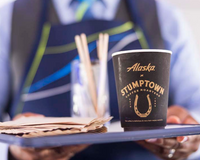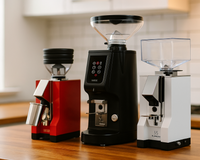The Ultimate Guide to Brewing the Perfect Cup of Coffee for Coffee Shops: Unleash the Best Flavors and Boost Customer Satisfaction!
Are you a coffee shop owner or barista looking to elevate your coffee game and provide the ultimate coffee experience to your customers? Look no further! In this comprehensive guide, we will take you on a journey to brewing the perfect cup of coffee that will have your customers coming back for more.
At Cliff & Pebble, we understand the importance of a great cup of coffee. That's why we've curated this ultimate guide to help you unleash the best flavors and boost customer satisfaction. From selecting the right coffee beans to mastering the art of brewing, we've got you covered.
Discover the secrets behind achieving the perfect balance of aroma, flavor, and body in every cup. Explore different brewing methods, grind sizes, water temperatures, and extraction times to bring out the full potential of your coffee beans. Whether you're serving espressos, lattes, or pour-overs, this guide will equip you with the knowledge and techniques to consistently deliver exceptional coffee to your customers.
Join us on this coffee brewing adventure and leave your customers craving for more. Let's brew the perfect cup of coffee together!
Why is brewing the perfect cup of coffee important for coffee shops?
Brewing the perfect cup of coffee is paramount for coffee shops as it directly impacts the overall customer experience and satisfaction. In a highly competitive market, where coffee enthusiasts have a plethora of options, consistently delivering exceptional coffee can be a game-changer for your business.
When customers visit your coffee shop, they are not just seeking a caffeine fix, but an immersive, sensory experience that captivates their taste buds and leaves them craving for more. A perfectly brewed cup of coffee, with its harmonious balance of aroma, flavor, and body, can elevate their mood, spark conversations, and create a lasting impression.
Moreover, brewing the perfect cup of coffee is a reflection of your commitment to quality, attention to detail, and dedication to your craft. It showcases your expertise as a coffee professional and demonstrates your willingness to go the extra mile to ensure customer satisfaction. This, in turn, can lead to increased customer loyalty, positive word-of-mouth, and ultimately, a thriving and successful coffee shop business.

The science behind brewing coffee - understanding extraction and flavor profiles
Brewing the perfect cup of coffee is a delicate balance of science and art. At the heart of this process lies the concept of extraction, which is the process of dissolving the soluble compounds from the coffee grounds into the water.
The key to achieving the perfect extraction lies in understanding the various factors that influence it, such as grind size, water temperature, brewing time, and coffee-to-water ratio. Each of these elements plays a crucial role in determining the final flavor profile of the coffee.
For instance, a coarse grind size will result in a slower extraction, leading to a lighter, more acidic cup of coffee, while a fine grind size will result in a faster extraction, producing a richer, more intense flavor. Similarly, water temperature can significantly impact the extraction process, with hotter water extracting more quickly and potentially producing a more bitter taste, while cooler water may result in a weaker, less developed flavor.
By mastering the science behind brewing, coffee shop owners and baristas can consistently produce coffee that showcases the unique flavor profiles of their chosen beans. This knowledge allows them to make informed decisions, adjust their brewing parameters, and deliver a consistently exceptional cup of coffee to their customers.
Selecting the right coffee beans for the perfect cup
The foundation of a perfect cup of coffee lies in the quality and selection of the coffee beans. As a coffee shop owner or barista, it is essential to understand the nuances of different coffee bean varieties, origins, and roast profiles to make an informed decision that aligns with your customers' preferences.
When selecting coffee beans, consider factors such as the bean's origin, processing method, and roast level. Each origin, from the lush highlands of Ethiopia to the volcanic slopes of Colombia, can impart distinct flavor notes, ranging from bright, fruity acidity to rich, chocolatey undertones.
The processing method, whether it's washed, natural, or honey-processed, can also significantly impact the final flavor profile of the coffee. Washed coffees tend to be cleaner and more balanced, while natural-processed coffees often exhibit bold, fruity notes. Understanding these differences can help you curate a coffee menu that caters to the diverse tastes of your customers.
Furthermore, the roast level of the coffee beans plays a crucial role in determining the overall flavor and aroma. Light roasts typically showcase the bean's inherent characteristics, with a brighter acidity and more delicate flavors. Medium roasts offer a well-rounded balance of sweetness, acidity, and body, while dark roasts tend to have a deeper, more robust flavor profile with notes of caramel or dark chocolate.
By carefully selecting the right coffee beans and understanding their unique properties, you can create a menu that showcases the best flavors and aromas, ultimately delivering an exceptional coffee experience to your customers.

The importance of grind size and its impact on flavor
The grind size of your coffee beans is a critical factor in achieving the perfect cup of coffee. The size of the coffee grounds directly affects the surface area exposed to the water during the brewing process, which in turn, impacts the extraction and the final flavor profile.
A coarse grind size will result in a slower extraction, as the water has less surface area to interact with the coffee grounds. This can lead to a lighter, more acidic cup of coffee, as the soluble compounds are not fully extracted. Conversely, a fine grind size will increase the surface area, resulting in a faster extraction and a more intense, potentially over-extracted cup of coffee with bitterness and astringency.
Finding the optimal grind size for your brewing method is essential for unlocking the full potential of your coffee beans. For example, espresso requires a very fine grind to achieve the necessary pressure and extraction, while a French press or pour-over may benefit from a coarser grind to avoid over-extraction.
By carefully adjusting the grind size, you can fine-tune the extraction process and achieve the perfect balance of sweetness, acidity, and body in your coffee. This attention to detail not only enhances the overall flavor but also ensures consistency across your menu, allowing your customers to enjoy a consistently exceptional cup of coffee every time they visit your coffee shop.
Brewing methods for the best flavors - drip brewing, French press, pour-over, espresso
As a coffee shop owner or barista, mastering a variety of brewing methods is essential to cater to the diverse preferences of your customers. Each brewing technique has its unique characteristics and can bring out different flavor profiles in the coffee.
Drip brewing is a popular and convenient method, where hot water is slowly poured over the coffee grounds and filtered through a paper or metal filter. This method is known for producing a balanced, clean, and consistent cup of coffee, making it a reliable choice for high-volume coffee shops.
RELATED: FRENCH PRESS VS. MOKA POT
The French press, on the other hand, is a immersion-based brewing method that allows the coffee grounds to steep directly in hot water. This results in a fuller-bodied, more robust cup of coffee, with a distinct mouthfeel and a deeper extraction of the coffee's natural oils and flavors.
Pour-over brewing, a manual and artisanal approach, involves slowly pouring hot water over a bed of coffee grounds, allowing the water to slowly percolate through and extract the desired flavors. This method is often praised for its ability to highlight the nuanced characteristics of the coffee beans, providing a more delicate and complex cup.
Espresso, the foundation of many coffee shop beverages, is a concentrated extraction method that uses high pressure to extract a small amount of coffee. This results in a bold, intense, and concentrated shot of coffee that forms the base for drinks like cappuccinos, lattes, and americanos. Mastering the art of espresso extraction is crucial for delivering consistent and exceptional espresso-based drinks.
By offering a diverse range of brewing methods, you can cater to the preferences of your customers, showcase the versatility of your coffee beans, and provide a memorable coffee experience that keeps them coming back for more.

Water quality and temperature for optimal extraction
The quality and temperature of the water used for brewing coffee play a crucial role in achieving the perfect cup. Water is the primary solvent in the coffee extraction process, and its composition can significantly impact the final flavor profile of the coffee.
Ideally, the water used for brewing should be clean, filtered, and free of impurities that can alter the taste of the coffee. Minerals like calcium and magnesium, as well as the pH level of the water, can affect the extraction process and the overall balance of the coffee.
RELATED: WHAT TYPE OF WATER SHOULD I USE IN MY LELIT ESPRESSO MACHINE
The temperature of the water is also a critical factor in the extraction process. The optimal brewing temperature range is typically between 195°F and 205°F (91°C and 96°C). Water that is too hot can result in an over-extracted, bitter cup of coffee, while water that is too cool may lead to an under-extracted, weak, and sour cup.
By maintaining the proper water temperature and ensuring the quality of the water used for brewing, you can consistently extract the desired flavors and aromas from your coffee beans. This attention to detail not only enhances the overall taste of the coffee but also helps to ensure that each cup meets the high standards expected by your discerning customers.
The role of equipment in brewing the perfect cup - coffee grinders, coffee makers, espresso machines
The equipment used in your coffee shop plays a crucial role in brewing the perfect cup of coffee. From the coffee grinder to the espresso machine, each piece of equipment contributes to the final outcome, and it is essential to invest in high-quality, well-maintained tools to ensure consistent and exceptional results.
The coffee grinder is perhaps the most important piece of equipment in your coffee shop, as it determines the size and consistency of the coffee grounds, which, as we've discussed, significantly impacts the extraction and flavor profile. Invest in a burr grinder, which produces a more uniform grind compared to blade grinders, and ensure that it is regularly cleaned and calibrated to maintain optimal performance.
Shop Espresso Machines from Cliff & Pebble >
The coffee maker, whether it's a drip brewer, French press, or pour-over setup, must be well-maintained and capable of precisely controlling the water temperature and flow rate. Proper maintenance, such as regular cleaning and descaling, can help ensure that your coffee maker consistently delivers the perfect extraction.
For espresso-based drinks, the espresso machine is the heart of your operation. Investing in a high-quality, commercial-grade espresso machine with features like temperature control, pressure profiling, and consistent shot volume can make a significant difference in the quality and consistency of your espresso-based beverages. Proper maintenance and barista training are essential to ensure that the machine is operating at its peak performance.
Shop Coffee Grinders from Cliff & Pebble >
By carefully selecting and maintaining the right equipment, you can create an environment that supports the art of brewing the perfect cup of coffee, allowing your baristas to consistently deliver exceptional results and exceed your customers' expectations.

Techniques for enhancing flavors - blooming, pre-infusion, brew ratios
Beyond the basics of brewing, there are several advanced techniques that coffee shop owners and baristas can employ to further enhance the flavor profile of their coffee. These techniques involve fine-tuning the brewing process to extract the best possible flavors from the coffee beans.
One such technique is blooming, which involves pouring a small amount of hot water over the coffee grounds and allowing them to "bloom" for 30 seconds to a minute before completing the full brew. This process allows the coffee to release carbon dioxide, which can help improve the overall extraction and enhance the coffee's aroma and flavor.
Another technique is pre-infusion, which involves briefly wetting the coffee grounds with a small amount of water before the full brew. This helps to ensure even saturation of the grounds, which can lead to a more consistent and balanced extraction. This method is particularly useful for espresso, where achieving the perfect pre-infusion can be the key to a well-balanced shot.
Brew ratios, the relationship between the amount of coffee and the amount of water used, are also crucial in achieving the perfect cup of coffee. The ideal brew ratio can vary depending on the brewing method, the coffee bean, and personal preference. By experimenting with different brew ratios, you can find the sweet spot that brings out the best in your coffee beans and satisfies the taste buds of your customers.
Mastering these advanced techniques requires a deep understanding of the science behind coffee extraction and a commitment to continuous learning and experimentation. By incorporating these methods into your coffee shop's brewing practices, you can elevate the overall quality and consistency of your coffee offerings, further delighting your customers and setting your establishment apart from the competition.
Training your baristas in the art of brewing the perfect cup
Brewing the perfect cup of coffee is not just about the equipment and the techniques – it's also about the skilled hands and the trained minds of your baristas. Investing in comprehensive barista training is essential to ensure that your coffee shop consistently delivers exceptional coffee experiences to your customers.
Your baristas should be well-versed in the science behind coffee extraction, understanding the impact of factors like grind size, water temperature, and brew ratios. They should also be proficient in a variety of brewing methods, from drip brewing to espresso pulling, and be able to adjust their techniques to bring out the best in your coffee beans.
Beyond the technical aspects, your baristas should also be trained in the art of customer service and the importance of creating a memorable coffee experience. They should be able to engage with customers, understand their preferences, and provide recommendations that cater to their individual tastes. This level of personalized attention can go a long way in building customer loyalty and fostering a positive reputation for your coffee shop.
Invest in ongoing training and development for your baristas, ensuring that they stay up-to-date with the latest industry trends, techniques, and best practices. Encourage them to participate in coffee tastings, attend industry events, and continuously refine their skills. By empowering your baristas and nurturing their passion for coffee, you can create a team of coffee experts who will deliver the perfect cup of coffee every time, leaving your customers truly satisfied and eager to return.
Customer satisfaction and the impact of brewing the perfect cup
At the heart of brewing the perfect cup of coffee lies the ultimate goal of customer satisfaction. When your customers are greeted with a consistently exceptional coffee experience, it can have a profound impact on their overall perception of your coffee shop and their loyalty to your brand.
A perfectly brewed cup of coffee can evoke a sense of delight and anticipation in your customers, setting the tone for a memorable visit. The harmonious balance of aroma, flavor, and body can transport them to a state of blissful contentment, leaving them craving for more. This positive experience can lead to repeat visits, word-of-mouth referrals, and ultimately, the growth and success of your coffee shop.
On the other hand, a poorly brewed cup of coffee can quickly erode customer trust and tarnish the reputation of your establishment. Customers who are dissatisfied with the quality of their coffee are less likely to return and may even share their negative experiences with others, potentially deterring potential customers from visiting your coffee shop.
By consistently delivering the perfect cup of coffee, you can establish your coffee shop as a destination for coffee enthusiasts, a place where they can indulge in a truly exceptional and memorable coffee experience. This, in turn, can translate into increased customer loyalty, positive reviews, and a thriving, successful coffee shop business that stands out in a crowded market.















